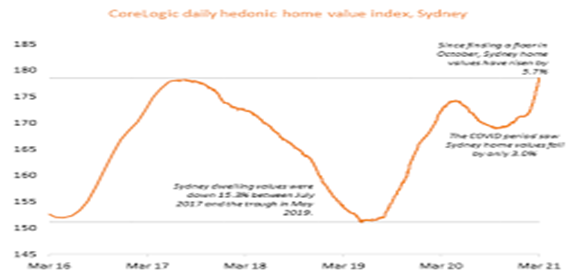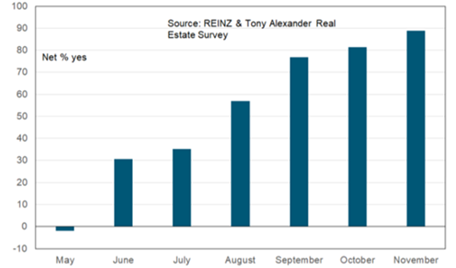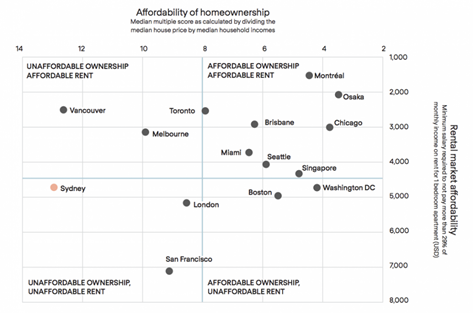Strategic Planning Assignment: Challenges For Affordable Housing In Sydney
Question
Task:
Write a strategic planning assignment critically discussing the challenges encountered while looking for affordable housing in Sydney, the strategic policies including both current initiatives and approaches of implementing these in affordable housing.
Answer
Executive Summary
The study developed in this strategic planning assignment focuses on the background context and the challenges faced while looking for affordable housing in Sydney, the strategic policies including both current initiatives and approaches of implementing these in affordable housing. People from middle household income depends on market-based technologies to access affordable housing. This ensures the cities access investor confidence and public confidence via different measures.
Introduction
A large number of people come to cities for better living and various opportunities. But the problem is that cities face a lot of pressure to provide house to poor people. People from middle household income depends on market-based technologies to access affordable housing. This ensures the cities access investor confidence and public confidence via different measures. Racial discrimination has severely affected the population with low income. This is higher than the discrimination against those having physical disabilities. There are claims that the housing supply fails to meet the rising demands. This, in turn, affects its affordability. Lack of access to housing affordability led to stress. Housing stress is very high in Sydney. The expectations of the additional development in contribution are connected to various planning decisions that are favorable to the situation, so that the expectations should not discourage the low costing market. The racial discrimination in perceived and fundamental housing markets produce a social barrier related to affordable housing.
Liberal and unlimited land supply will contribute to a development that is very much dispersed and expensive. This deteriorates the environmental values as well as the landscapes. This is done by shifting the land for conservation or farming practices. Planning controls can sometimes help to lower the cost of housing. Nowadays, many Australian states and territories, including Sydney have decided to simplify their planning as well as planning controls in order to decrease the standard development regulation and lessen the time to plan. The report focuses on the background context and the challenges faced while looking for affordable housing in Sydney, the strategic policies including both current initiatives and approaches of implementing these in affordable housing. This paper also focuses on shaping challenges, opportunities, barriers, initiatives and understanding from a case study. This also discusses directions to help develop the policies.
Background
Strategic interest
As Sydney's population is estimated to grow by nearly 1.8 million in the next 20 years, there is a need for an additional 800,000 houses across Sydney. Without any planned strategy, it isn't easy to build houses. This is because there is an increase in the cost of housing along with lower income. There are claims that the housing supply fails to meet the rising demands. To encourage the federal government to resume the affordability scheme of housing.To reduce the cost of the land for affordable housing, the overall cost should be reduced. The developers of affordable housing are required to increase the debt for an extended period. This means they paid higher interest.This, in turn, affects its affordability. Many homeless people can never change their situations (Van Der Merwe 2018). Thus, need for security can be achieved if they put few years of the lease for the tenants. The rental markets allowing ancient complexes with minimal amenities can be reasonably priced. But this is not a perfect solution; instead, it can help a little.

Figure 1: Hike in house prices in Sydney
(Source: Van Der Merwe 2018)
If planning is controlled in a proper way, it will promote objectives or goals of the community, starting from health and safety measurements to protecting and preserving cultural heritage. Lack of access to housing affordability led to stress. Housing stress is very high in Sydney. The estimated percentage of lower-income in metropolitan Sydney is about 60 per cent.On the other hand, they pay more than 35 per cent of their income on the housing costs. Housing stress harms people's health as due to an increase in cost, they tend to cut down their essentials like food (Siddiq, Tang and Zhang 2020).
There is another disadvantage of housing stress due to lowered access to employment and transport. In the year 2007, the NUHHP has set goals for achieving housing facilities that should be affordable. The Council maintain diversity in the housing structures. They help mitigate the housing stress of many families or individuals who live in the rental market. This also allows identifying various sites for suitable and affordable housing. The government increased the time for completing the projects from three to five years. They reduced the period of long-term gains for the capital set for affordable housing. The qualifying criteria are converted from saleable to the carpet area.
Key issues focused on primer
Challenges faced in affordable housing
As per Bangura and Lee (2019), Sydney will be in big trouble as it is facing an affordable crisis in housing and if proper action is not taken. The price increase is for both homeowners and renters. The challenges faced in affordable housing are described below-
More rental housing
To get relief from housing stress, it is best to build rental housing. Popular cities in Australia can do better if the building density and back off on different planning systems are involved in slow development. Research shows a group that believes that if tax policies are changed to develop more rental housing, it is another tool to complete the development process. This ensures the need of relaxing the rules and regulations.
Supply and demand
According to Gold and Gold (2020), when people get occupied with the facts like zoning, density and regulation, they tend to forget that people might get hurt. Nearly 1.5 million people need housing facilities, whether they are not able to access the housing market. If 40% of the income is paid to rent, it affects the savings of the people. Many homeless people can never change their situations (Van Der Merwe 2018). Thus, need for security can be achieved if they put few years of the lease for the tenants.
Need of Federal and state intervention
Australia needs massive investment from the federal and state government. Different tools are made to leverage the private markets that need to involve extensive state intervention. The private markets are not at all suitable to deploy an affordable housing strategy. The rental markets allowing ancient complexes with minimal amenities can be reasonably priced. But this is not a perfect solution; instead, it can help a little.
Strategic policy
Current initiatives
As opined by Guillery and Kroll (2019), housing affordability is the foremost priority of the NSW government. There is more interest to determine the efficient ways to plan systems to produce more affordable housing supplies. Developmental contributions are gathered as impact fees in many parts of the United States. This type of discrimination is present in significant proportions among the people who fall under the population with low to middle income.
The present planning which increases affordable housing structures are:
- Planning policy of State Environment- this delivers incentives to develop or create affordable projects in housing.
- State Environment Policy no. 70 allows very few councils to gather funds to supply more affordable housing.
The current approach of the Council
As per Harris (2018), additional affordable housing supplies are mainly coming from Canada Bay. This is done via its present portfolio and preparing a rationale to produce good quality additional housing structures. The Council maintain diversity in the housing structures. They help mitigate the housing stress of many families or individuals who live in the rental market. This also allows identifying various sites for suitable and affordable housing.
Perceived opportunities
- To reduce the cost of the land for affordable housing, the overall cost should be reduced. The developers of affordable housing are required to increase the debt for an extended period. This means they paid higher interest.
- Instead of public land sales. The government should retain equity in exchange development of the land. This long-term approach allows the government to receive awards.
- Lands should be treated as an excellent social platform.
- Increased cooperative housing.
Barriers
- The group of affordable housing comprises nearly 35 members, including private and public sectors and local governments, non-profit builders, human agencies, realtors, etc., to meet the regional policy for a strategic plan.
- The barriers inhibiting the affordable housing facility is prepared by housing and development corporation by South Florida.
- Staff members of the local government of affordable housing.
- Increasing costs of lend and construction process.
As stated by Kholodilin, Limonov and Waltl (2021), barriers are developed when this type of housing is very far from public transportation and other physical amenities. People who are suffering from any disabilities are more prone to housing discrimination.This type of discrimination is present in significant proportions among the people who fall under the population with low to middle income.
Racial discrimination has severely affected the population with low income. This is higher than the discrimination against those having physical disabilities. The racial discrimination in perceived and fundamental housing markets produce a social barrier related to affordable housing.Low finance literacy and less knowledge in financial literacy is also a potential barrier.

Figure 2: Rack-rent housing crisis in Sydney
(Source: Harris, 2018)
Previous initiatives for affordable housing
As per Pettit, Tice and Randolph (2017), the government has taken few initiatives to provide the poor sections of the society with affordable housing facilities. The measures were taken around fifteen years. In the year 2007, the NUHHP has set goals for achieving housing facilities that should be affordable. The qualifying criteria are converted from saleable to the carpet area. The government has given one year to those paying taxes on rental income on sold or unsold, or completed units.
Policy development
The government has set various policies to make housing affordable to everyone, especially those who belong to lower to the moderate-income household. The policies of the Australian government are as follows-
Land release policy and plan
To avoid any further surges in the price of housing and shortages in supply, the growth in outer urban and established areas is becoming more desirable. If the land supply in the outer urban areas is liberal, it will undermine the market. Liberal and unlimited land supply will contribute to a development that is very much dispersed and expensive.
Remove barriers to enhance affordable housing
Planning requirements being costly and complex, it becomes an attack on the system of planning affordable housing. If planning is controlled in a proper way, it will promote objectives or goals of the community, starting from health and safety measurements to protecting and preserving cultural heritage. Planning controls can sometimes help to lower the cost of housing.
Funding for infrastructure
As opined by Holmes (2021), the planning charges for compulsory infrastructures are high in nature. At this point, it becomes problematic to generalize each and every state or other local or territorial jurisdiction.The attempts made to shift the developmental process of the infrastructure funding provides a threat to the housing supply in the near future.Developmental contributions are gathered as impact fees in many parts of the United States.
Forward directions or levers for the Tsar to improve the policy development
The goals of large and affordable housing cannot be obtained through simple solutions because different household have different problems. This type of portfolio is generated and raised through funds. Such dwellings provide affordable rental housing to lower household incomes (Witten, 2018). The Council owns the portfolio and tenancy services through a registered housing provider.
It could be achieved with the introduction of a proper framework for affordable housing with the help of government. These are the fees that are allowed to offset the effects of the process on the present community present in the locality. People who are suffering from any disabilities are more prone to housing discrimination. According to Nasreen(2018, June), few decisions are put forward to the Tsar in order to make improvements in the policy development are described below-
- To make improvement in the housing affordability in NSW across the state, especially Sydney, where the city faces a lot of challenges.
- To boost or increase the diversity, supply and affordability in housing infrastructure. This is done by taking strategic projects into consideration in Sydney for various types of solutions for potential and affordable housing.
- To determine the household incomes that the buyers are paying for their houses and then bring out a comparison between them and a benchmark figure. Comparing with the benchmark allows them to know that those who are paying more than 35% of their incomes on housing are in high housing stress. Knowing the cause of stress, solutions can also be achieved.
- To determine the amount that is left to the people after paying their household rents and thus making a comparison out of it to the standard measures of the optimal income required to fulfil basic costings of housing and other basic costs for passing the lives.
- To encourage the federal government to resume the affordability scheme of housing.
- Allowing for flexible housing.
- To reinvigorate traditions to be self-build.

Figure 3: Housing affordability issues in Sydney
(Source: Witten, 2018)
The local and planning strategy of the Council investigates the zoning for the affordable housing system. The affordable housing planning generated at Rhodes East will add a tiny portfolio of how to implement affordable housing. This discourages the developers from investing in housing infrastructure as the owners of the land demand high prices. Thus, the measures mentioned above are expected to provide an outline about the number of households who are under severe housing stress.
This deteriorates the environmental values as well as the landscapes. Potential barriers while using governmental programs need to be adequately examined so that there arises no problem regarding affordable housing infrastructure. This is done by shifting the land for conservation or farming practices (Zatsepine, 2017). To mitigate the stress, the measures should be adopted as soon as possible. Nowadays, many Australian states and territories, including Sydney have decided to simplify their planning as well as planning controls in order to decrease the standard development regulation and lessen the time to plan.
Conclusion
From the report, it is concluded that a wide range of opportunities and challenges are introduced in building affordable housing infrastructure. It offers inspiration to the Tsar of the organisation to tackle the crisis involved in affordable housing. The goals of large and affordable housing cannot be obtained through simple solutions because different household have different problems. It could be achieved with the introduction of a proper framework for affordable housing with the help of government.
Reference list
Bangura, M. and Lee, C.L., (2019). The differential geography of housing affordability in Sydney: a disaggregated approach. Australian Geographer, 50(3), pp.295-313.https://www.tandfonline.com/doi/abs/10.1080/00049182.2018.1559971
Gold, J.R. and Gold, M.M., (2020). Festival Cities: Culture, Planning and Urban Life. Routledge.https://books.google.com/books?hl=en&lr=&id=vNUDEAAAQBAJ&oi=fnd&pg=PP1&dq=housing+affordability+ tsar+in+sydney&ots=xPiRyDHNCU&sig=hrN0quD5SOyPqz06h3b9yORQjIU
Guillery, P. and Kroll, D., (2019). Mobilising Housing Histories: Learning from London's Past for a Sustainable Future. Routledge.https://books.google.com/books?hl=en&lr=&id=AJelDwAAQBAJ&oi=fnd&pg=PT14&dq=housing+affordability+tsar+in+ sydney&ots=xNWOB0xbSR&sig=x516hcq1C6P4qu0U6FWmL_AIuKE
Harris, C., (2018). The Black Organic Intellectual Tradition and the Challenges of Educating and Developing Organic Intellectuals in the 21st Century. The Journal of Intersectionality, 2(1), pp.51-107.https://www.jstor.org/stable/10.13169/jinte.2.1.0051
Holmes, R., (2021). Resilient Voices: Estonian Choirs and Song Festivals in World War II Displaced Person Camps. Routledge.https://books.google.com/books?hl=en&lr=&id=gfUlEAAAQBAJ&oi=fnd&pg=PP10&dq=housing+affordability+tsar+in+sydney& ots=f2YeVLcuX8&sig=3dAzPxtaw_GKBH_fQwZbMeUK4gg
Kholodilin, K.A., Limonov, L.E. and Waltl, S.R., (2021). Housing rent dynamics and rent regulation in St. Petersburg (1880–1917). Explorations in Economic History, p.101398.https://www.sciencedirect.com/science/article/pii/S0014498321000164
Nasreen, Z., (2018, June). Room Sharing: A solution or an exacerbation to rental housing affordability crisis in Sydney?. In-State of Australian Cities Conference, 28-30 Nov 2017.https://www.researchgate.net/profile/Zahra_Nasreen/publication/325986800_Room_Sharing_A_solution_ or_an_exacerbation_to_rental_housing_affordability_crisis_in_Sydney/links/5b31bd1eaca2720785e848af/ Room-Sharing-A-solution-or-an-exacerbation-to-rental-housing-affordability-crisis-in-Sydney.pdf
Pettit, C., Tice, A. and Randolph, B., (2017). Using an online spatial analytics workbench for understanding housing affordability in Sydney. In Seeing Cities Through Big Data (pp. 233-255). Springer, Cham.https://link.springer.com/chapter/10.1007/978-3-319-40902-3_14
Siddiq, A., Tang, C.S. and Zhang, J., (2020). Partnerships in Urban Mobility: Incentive Mechanisms for Improving Public Transit Adoption. Available at SSRN.https://papers.ssrn.com/sol3/papers.cfm?abstract_id=3540566
Van Der Merwe, C.G., (2018). Should Short-Term Letting Be Allowed in Sectional Title Schemes. JS Afr. L., p.507.https://heinonline.org/hol-cgi-bin/get_pdf.cgi?handle=hein.journals/jsouafl2018§ion=35
Witten, T., (2018). Pre-contractual assessments in mortgage loans: Promoting responsible lending or exacerbating financial exclusion?-A comparative study of the South African National Credit Act and the European Mortgage Credit Directive (Master's thesis, University of Cape Town).https://open.uct.ac.za/handle/11427/29718
Zatsepine, V., (2017). Beyond the Amur: Frontier Encounters Between China and Russia, 1850-1930. UBC Press.https://books.google.com/books?hl=en&lr=&id=Vt8lDgAAQBAJ&oi=fnd&pg=PP1&dq=housing+affordability+tsar+in+sydney& ots=uBEVC_VnJ_&sig=YEhxFw6UeC1VDKXTxuktYlNjuqM












